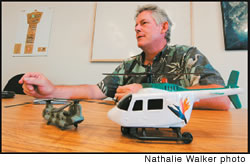Copter School
It’s not quick, easy or cheap, but a Honolulu school is teaching regular folks the complicated art-science of flying a helicopter
says. An online search for job listings shows most companies wanting much more than just the minimum.
“No one is going to touch you with a 10-foot pole if you have only 150-200 hours,” he says. “The only way to get 1,000 hours (what he considers the minimum for employment) is to become an instructor. That way you not only get your hours, but you get paid to do it.”
Cobb obviously agrees.
“My goal is to get my license by the end of the year, and then to become an instructor,” she says.
How she plans to add this to her already busy schedule of raising son Felice, 14, and daughter Bryanna, 12, while doing laser hair removal still remains to be seen, but her teachers are confident she can handle the workload. O’Reilley believes Cobb has what it takes to be a very good pilot, calling her a natural, a label that she shrugs off. “I’m not there yet,” she laughs. But that is the goal, and her instructors couldn’t be happier.

P.J. O’Reilley, manager of Mauna Loa Helicopters
“We get resumes faxed and emailed to us every day. But we like to hire people we have trained because we know exactly what they are capable of doing,” O’Reilley says.
The desire to hire locally is based on more than just comfort — there is a need for instructors in Hawaii and elsewhere.
“Let me put it this way. We’ve lost six instructors in two months,” he says. “Two went to Alaska, one is on Kauai, another transports oil workers in Louisiana and another one is in California.” Such is the nomadic life of a copter jockey.
For anyone who has sat behind a boring traffic simulator to get their driver’s license, they may think Mauna Loa would begin lessons in some huge flying machine that floats along at a snail’s pace. Oh, would they be surprised. The trainer of choice is the Robinson R-22. The small 124-horsepower eggbeater weights only 840 pounds and is capable of speeds up to 102 knots (110 mph) with a ceiling of 14,000 feet, though chilly temperatures keep the flying to around the 2,000 feet level.
Most who train in the small craft appreciate the quick response that O’Reilley compares to a motorcycle in that even the slightest motion on the controls is immediately felt. Some new passengers, however, are surprised once in a while.
“When they take up friends or family for the first time they may think ‘what are you taking me up in?’ They think it looks like it’s radio-controlled,” he says.
The small size of the copter may bring caution to some, but the size seems to fit the diminutive Cobb.

Leona Cobb and flight instructor Doug Froning
in tight quarters
However, like many of us, she still needs a boost on occasion. Hers comes from a six-inch cushion. The pad is not to make her taller, at 5-feet-2-inches tall, it’s to make her longer. “I can’t reach the pedals without it,” she says.
From John Wayne’s Flying Leathernecks to Mel Gibson’s Air America, pilots have been portrayed in popular culture as extremely confident adrenaline junkies, but Cobb refuses to give in to any animated displays. No odes to Helen Reddy or braburning defiance against perceived inabilities, she just wants to fly and doesn’t care if anyone knows about it or not.
But when pushed, she does admit that it feels good to accomplish her goals.
“It’s fun to prove them wrong,” she says in response to her critics.
O’Reilley knows the time may come when Leona takes her training and leaves her friends at the airfield, but he says that’s part of what makes his job a fun one.
“It’s kind of like a fantasy,” he says. “Kids come in that you wouldn’t trust with your car keys and then you see them develop. It must be how an Army drill instructor feels when he sees his men develop. We are just so proud.”
Add mother Mae to that group.
“I am very proud of her. Very proud,” Mae says. “She is my youngest daughter. She was the one who always gave me problems. I never thought she would settle down and do the EMT thing and the helicopter thing. It’s good for her children also. We try to tell them ‘you should be proud of your mom.’”
It seems one person’s embarrassment is another’s good story.
Page 2 of 2 pages for this story < 1 2
E-mail this story | Print this page | Comments (0) | Archive | RSS
Most Recent Comment(s):








